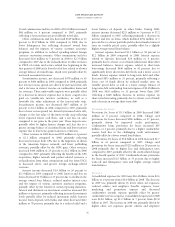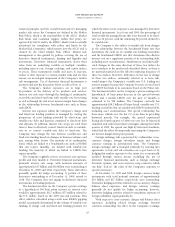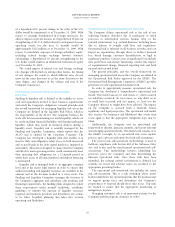American Express 2009 Annual Report Download - page 42
Download and view the complete annual report
Please find page 42 of the 2009 American Express annual report below. You can navigate through the pages in the report by either clicking on the pages listed below, or by using the keyword search tool below to find specific information within the annual report.2009 FINANCIAL REVIEW
AMERICAN EXPRESS COMPANY
The Company seeks to maintain capital levels and ratios in
excess of the minimum regulatory requirements; failure to
maintain minimum capital levels could cause the respective
regulatory agencies to take actions that could limit the
Company’s business operations.
The Company’s primary source of equity capital has been
through the generation of net income. Historically, capital
generated through net income and other sources, such as the
exercise of stock options by employees, has exceeded the
growth in its capital requirements. To the extent capital has
exceeded business, regulatory and rating agency
requirements, the Company has returned excess capital to
shareholders through its regular common dividend and the
share repurchase program.
The Company maintains certain flexibility to shift capital
across its businesses as appropriate. For example, the
Company may infuse additional capital into subsidiaries to
maintain capital at targeted levels in consideration of debt
ratings and regulatory requirements. These infused amounts
can affect the capital profile and liquidity levels for American
Express’ Parent Company (Parent Company).
During 2009, the Company returned $855 million in
dividends to shareholders, which represents approximately
46 percent of total capital generated.
U.S. DEPARTMENT OF TREASURY CAPITAL PURCHASE
PROGRAM
On January 9, 2009, under the United States Department of
the Treasury (Treasury Department) Capital Purchase
Program (CPP), the Company issued to the Treasury
Department for aggregate proceeds of $3.39 billion:
(1) 3.39 million shares of Fixed Rate (5 percent) Cumulative
Perpetual Preferred Shares, Series A, and (2) a ten-year
warrant (the Warrant) for the Treasury Department to
purchase up to 24 million common shares at an exercise price
of $20.95 per share. The Company repurchased the Preferred
Shares from the Treasury Department at par on June 17,
2009, and repurchased the Warrant for $340 million on
July 29, 2009. Refer to Note 14 to the Consolidated Financial
Statements for further discussion of this program.
SHARE REPURCHASES AND DIVIDENDS
The Company has a share repurchase program to return
excess capital to shareholders. These share repurchases reduce
shares outstanding and offset, in whole or part, the issuance of
new shares as part of employee compensation plans.
On a cumulative basis, since 1994 the Company has
distributed 67 percent of capital generated through share
repurchases and dividends. No shares have been repurchased
over the past seven quarters, as share repurchases were
suspended during the first quarter of 2008 in light of the
challenging global economic environment and limitations
while under the CPP.
FUNDING STRATEGY
The Company seeks to maintain broad and well-diversified
funding sources to allow it to meet its maturing obligations,
cost-effectively finance current and future asset growth in its
global businesses as well as to maintain a strong liquidity
profile. The diversity of funding sources by type of debt
instrument, by maturity and by investor base, among other
factors, provides additional insulation from the impact of
disruptions in any one type of debt, maturity, or investor. The
mix of the Company’s funding in any period will seek to
achieve cost-efficiency consistent with both maintaining
diversified sources and achieving its liquidity objectives. The
Company’s funding strategy and activities are integrated into
its asset-liability management activities.
The Company’s proprietary card businesses are the
primary asset-generating businesses, with significant assets in
both domestic and international cardmember receivable and
lending activities. The Company’s borrowing needs are in
large part a consequence of its proprietary card-issuing
businesses and the maintenance of a liquidity position to
support all of its business activities, such as merchant
payments. The Company generally pays merchants for card
transactions prior to reimbursement by cardmembers and
therefore funds the merchant payments during the period
cardmember loans and receivables are outstanding. The
Company also has additional borrowing needs associated with
general corporate purposes.
FUNDING PROGRAMS AND ACTIVITIES
The Company meets its funding needs through a variety of
sources, including debt instruments such as senior unsecured
debentures, asset securitizations, deposits placed with the
Company’s U.S. banks by individuals and long-term
committed bank borrowing facilities in certain non-U.S.
markets.
40
























